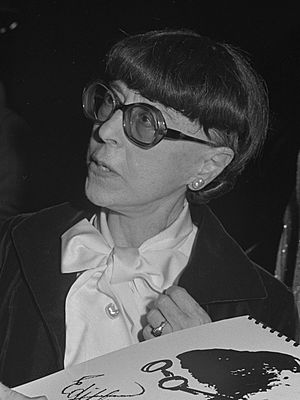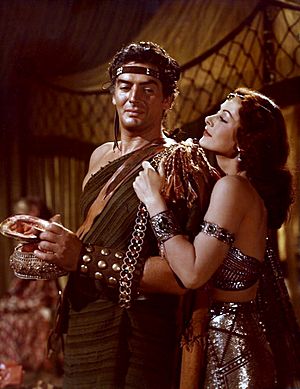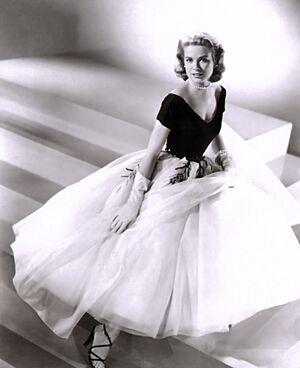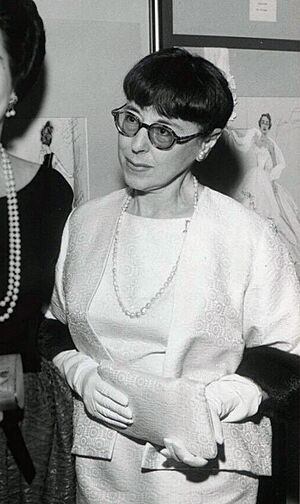Edith Head facts for kids
Quick facts for kids
Edith Head
|
|
|---|---|

Edith Head in 1976
|
|
| Born |
Edith Claire Posener
October 28, 1897 |
| Died | October 24, 1981 (aged 83) Los Angeles, California, U.S.
|
| Resting place | Forest Lawn Memorial Park, Glendale, California |
| Alma mater | University of California, Berkeley (B.A., 1919) Stanford University (M.A., 1920) |
| Years active | 1927–1981 |
| Spouse(s) |
Charles Head
(m. 1923; div. 1938)Wiard Ihnen
(m. 1940; died 1979) |


Edith Head (born October 28, 1897 – died October 24, 1981) was an amazing American costume designer. She won a record eight Academy Awards for Best Costume Design between 1949 and 1973. This makes her the woman with the most Oscar wins in the Academy's history! Many people think Edith Head was one of the best and most important costume designers ever in movies.
Edith grew up in California. She started her career teaching Spanish, but she was really interested in design. After studying at the Chouinard Art Institute in Los Angeles, she got a job at Paramount Pictures in 1923. She designed costumes for many famous movies. She became very well known after the Academy Award for Best Costume Design was created in 1948. Edith Head was special because she worked closely with the actors she designed for. She talked a lot with them to make sure their costumes were perfect. She worked with almost every big female star in Hollywood.
Edith Head worked at Paramount for 44 years. In 1967, she moved to Universal Pictures after being invited by director Alfred Hitchcock. There, she won her eighth and final Academy Award for her work on the movie The Sting in 1973.
Contents
Edith Head's Early Life and Start in Design
Edith Claire Posener was born in San Bernardino, California. Her parents were Max Posener and Anna E. Levy. Her father was from Germany, and her mother was from Missouri. They married in 1895. Before Edith was born, her father opened a small clothing store, but it closed quickly.
Her parents' marriage did not last. In 1905, her mother Anna married Frank Spare, who was a mining engineer. Edith's family moved often because of Frank's jobs. Edith later remembered living in Searchlight, Nevada for a while. Frank and Anna raised Edith as their own child.
In 1919, Edith earned a Bachelor of Arts degree from the University of California, Berkeley. She studied French and did very well. In 1920, she got a Master of Arts degree from Stanford University in languages.
She started her career as a language teacher. Her first job was teaching French at Bishop's School in La Jolla. After a year, she taught Spanish at the Hollywood School for Girls. To earn more money, she said she could also teach art. Even though she had only studied art briefly in high school, she decided to improve her drawing skills. She took evening classes at the Otis Art Institute and Chouinard Art College.
On July 25, 1923, she married Charles Head. He was the brother of one of her art classmates. Their marriage ended in 1938, but she kept the name Edith Head for her professional work. In 1940, she married Wiard Ihnen, who was a famous art director. They were married until he passed away in 1979.
Working at Paramount Pictures
In 1924, Edith Head was hired as a costume sketch artist at Paramount Pictures. She was 26 years old. She later admitted that she "borrowed" some sketches from other students for her job interview! She started designing costumes for silent films, like The Wanderer in 1925. By the 1930s, she was one of Hollywood's top costume designers. She worked at Paramount for 43 years. In 1967, she moved to Universal Pictures. This move might have happened because she worked a lot with director Alfred Hitchcock, who had moved to Universal in 1960.
Edith Head was nominated for 35 Academy Awards during her long career. She won eight times, which is more than anyone else! The Oscar for Best Costume Design started in 1949. Edith Head was nominated every year from 1949 to 1966.
Edith Head became very well known to the public. She designed the famous "sarong" dress for Dorothy Lamour in the movie The Hurricane (1937). This design made her famous. She also designed a special mink-lined gown for Ginger Rogers in Lady in the Dark (1944). This dress caused a lot of talk because it was during wartime, and people were used to simpler styles.
Edith Head had a special way of working. Unlike many male designers, she always talked a lot with the female stars she worked with. Because of this, she was a favorite among many leading actresses of the 1940s and 1950s. These stars included Ginger Rogers, Bette Davis, Grace Kelly, Audrey Hepburn, and Elizabeth Taylor. Other studios often asked Paramount to "loan out" Edith Head so she could design for their stars. Edith herself always dressed simply, wearing glasses and plain suits.
In 1946, Edith Head worked with director Alfred Hitchcock for the first time on his spy film Notorious. Edith believed it was important to design clothes that fit the character, not just her own style. She and Hitchcock got along well because they both had a direct way of working. The costumes she designed for Notorious were simple and helped the characters blend in, which was exactly what Hitchcock wanted. They worked together many more times.
Edith Head also wrote two books about her career and how she thought about design. These books were called The Dress Doctor (1959) and How To Dress For Success (1967).
Moving to Universal Pictures
In 1967, when she was 70 years old, Edith Head left Paramount Pictures and joined Universal Pictures. She stayed there until she passed away in 1981. By this time, Hollywood was changing. Movies were filmed more outdoors and on location, not just in studios. Many of the actresses she worked with had retired or were working less. So, Edith started working more on TV shows. She designed costumes for the TV show Bewitched. She even appeared as herself in a 1973 episode of the detective series Columbo, showing off her Oscars. In 1974, Edith Head won her last Oscar for her work on the movie The Sting.
In the late 1970s, Edith Head was asked to design a uniform for women in the United States Coast Guard. More women were joining the Coast Guard, and they needed a special uniform. Edith said this job was a highlight of her career. She even received an award for her efforts. Her designs for a TV mini-series based on the book Little Women were also very popular. Her last movie project was the comedy Dead Men Don't Wear Plaid (1982), starring Steve Martin. Edith was chosen for this movie because she was an expert on 1940s fashion. The movie was released after she died and was dedicated to her memory.
Her Passing
Edith Head passed away on October 24, 1981, just four days before her 84th birthday. She died from a bone marrow disease. She is buried at Forest Lawn Memorial Park in Glendale, California.
Hollywood Walk of Fame Star
Edith Head has a star on the Hollywood Walk of Fame. She received it in 1974. Her star is located at 6504 Hollywood Boulevard.
Actors and Actresses She Designed For
Edith Head designed costumes for many famous actors and actresses. Here are some of them:
- Mae West in She Done Him Wrong, 1933
- Dorothy Lamour in The Hurricane, 1937, and many "Road" movies
- Veronica Lake in Sullivan's Travels, 1941
- Barbara Stanwyck in Double Indemnity, 1944
- Ginger Rogers in Lady in the Dark, 1944
- Ingrid Bergman in Notorious, 1946
- Bette Davis in All About Eve, 1950
- Olivia de Havilland in The Heiress, 1949
- Hedy Lamarr in Samson and Delilah, 1949
- Gloria Swanson in Sunset Boulevard, 1950
- Elizabeth Taylor in A Place in the Sun, 1951
- Audrey Hepburn in Roman Holiday, 1953; Sabrina, 1954; Breakfast at Tiffany's, 1961
- Grace Kelly in Rear Window, 1954; To Catch a Thief, 1955
- Rosemary Clooney in White Christmas, 1954
- Shirley MacLaine in Artists and Models, 1955
- Doris Day in The Man Who Knew Too Much, 1956
- Marlene Dietrich in Witness for the Prosecution, 1957
- Lauren Bacall in Designing Woman, 1957
- Kim Novak in Vertigo, 1958
- Sophia Loren in That Kind of Woman, 1959
- Natalie Wood in Love with the Proper Stranger, 1963
- Tippi Hedren in The Birds, 1963
- Jane Fonda in Barefoot in the Park, 1967
- Katharine Hepburn in Rooster Cogburn, 1975
She also designed for actors like:
- Fred Astaire in Holiday Inn, 1942
- Danny Kaye in White Christmas, 1954
- Cary Grant in To Catch a Thief, 1955
- John Wayne in Hatari! 1962
- Steve Martin in Dead Men Don't Wear Plaid, 1982
- Elvis Presley in Blue Hawaii, 1961
Her Academy Awards
Edith Head won eight Academy Awards for Best Costume Design. She was nominated 35 times!
| Year | Category | Work | Result |
|---|---|---|---|
| 1948 | Best Costume Design - Color | The Emperor Waltz | Nominated |
| 1949 | Best Costume Design - Black & White | The Heiress | Won |
| 1950 | Best Costume Design - Color | Samson and Delilah | Won |
| Best Costume Design - Black & White | All About Eve | Won | |
| 1951 | A Place in the Sun | Won | |
| 1952 | Best Costume Design - Color | The Greatest Show on Earth | Nominated |
| Best Costume Design - Black & White | Carrie | Nominated | |
| 1953 | Best Costume Design - Black & White | Roman Holiday | Won |
| 1954 | Sabrina | Won | |
| 1955 | Best Costume Design - Color | To Catch a Thief | Nominated |
| Best Costume Design - Black & White | The Rose Tattoo | Nominated | |
| 1956 | Best Costume Design - Color | The Ten Commandments | Nominated |
| Best Costume Design - Black & White | The Proud and Profane | Nominated | |
| 1957 | Best Costume Design | Funny Face | Nominated |
| 1958 | The Buccaneer | Nominated | |
| 1959 | Best Costume Design - Color | The Five Pennies | Nominated |
| Best Costume Design - Black & White | Career | Nominated | |
| 1960 | Best Costume Design - Color | Pepe | Nominated |
| Best Costume Design - Black & White | The Facts of Life | Won | |
| 1961 | Best Costume Design - Color | Pocketful of Miracles | Nominated |
| 1962 | My Geisha | Nominated | |
| Costume Design - Black & White | The Man Who Shot Liberty Valance | Nominated | |
| 1963 | Best Costume Design - Color | A New Kind of Love | Nominated |
| Best Costume Design - Black & White | Wives and Lovers | Nominated | |
| Love with the Proper Stranger | Nominated | ||
| 1964 | Best Costume Design - Color | What a Way to Go! | Nominated |
| Best Costume Design - Black & White | A House Is Not a Home | Nominated | |
| 1965 | Best Costume Design - Color | Inside Daisy Clover | Nominated |
| Best Costume Design - Black & White | The Slender Thread | Nominated | |
| 1966 | Best Costume Design - Color | The Oscar | Nominated |
| 1969 | Best Costume Design | Sweet Charity | Nominated |
| 1970 | Airport | Nominated | |
| 1973 | The Sting | Won | |
| 1975 | The Man Who Would Be King | Nominated | |
| 1977 | Airport '77 | Nominated |
Guest Appearances in Film and TV
Edith Head also appeared as herself in some movies and TV shows.
- She made a brief appearance in the Columbo: Requiem for a Falling Star (1973) episode. She played herself as a clothing designer for Anne Baxter's character. Her real Oscars were shown on a desk in the scene!
- She also appeared in the film Lucy Gallant (1955) as the host of a fashion show.
- In The Pleasure of His Company (1961), she showed dresses for Debbie Reynolds' wedding in the movie.
- She had three short, non-speaking scenes in The Oscar (1966). In this movie, she appeared with Elke Sommer's character, who was also a sketch artist who became a costume designer, just like Edith.
See also
 In Spanish: Edith Head para niños
In Spanish: Edith Head para niños


